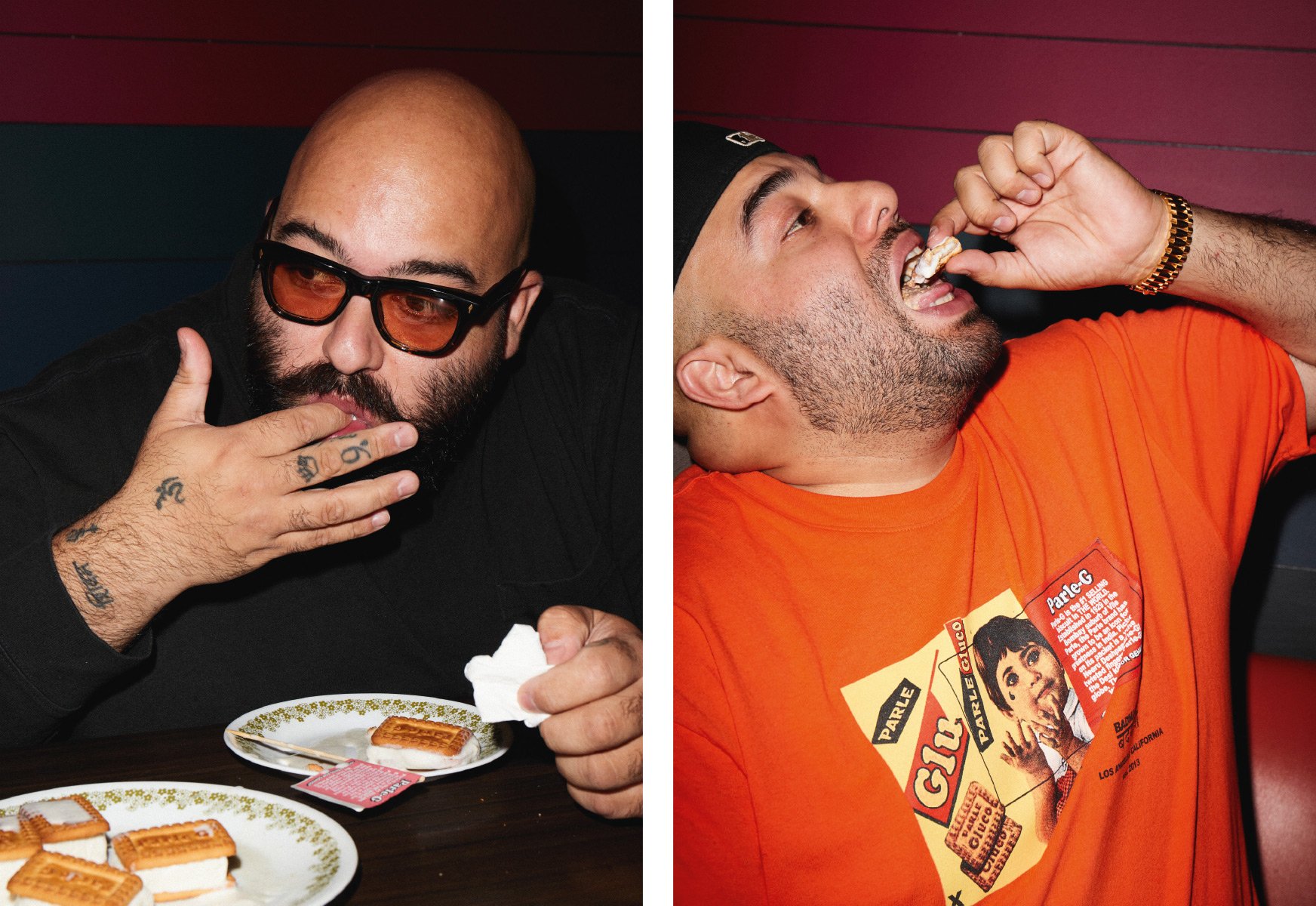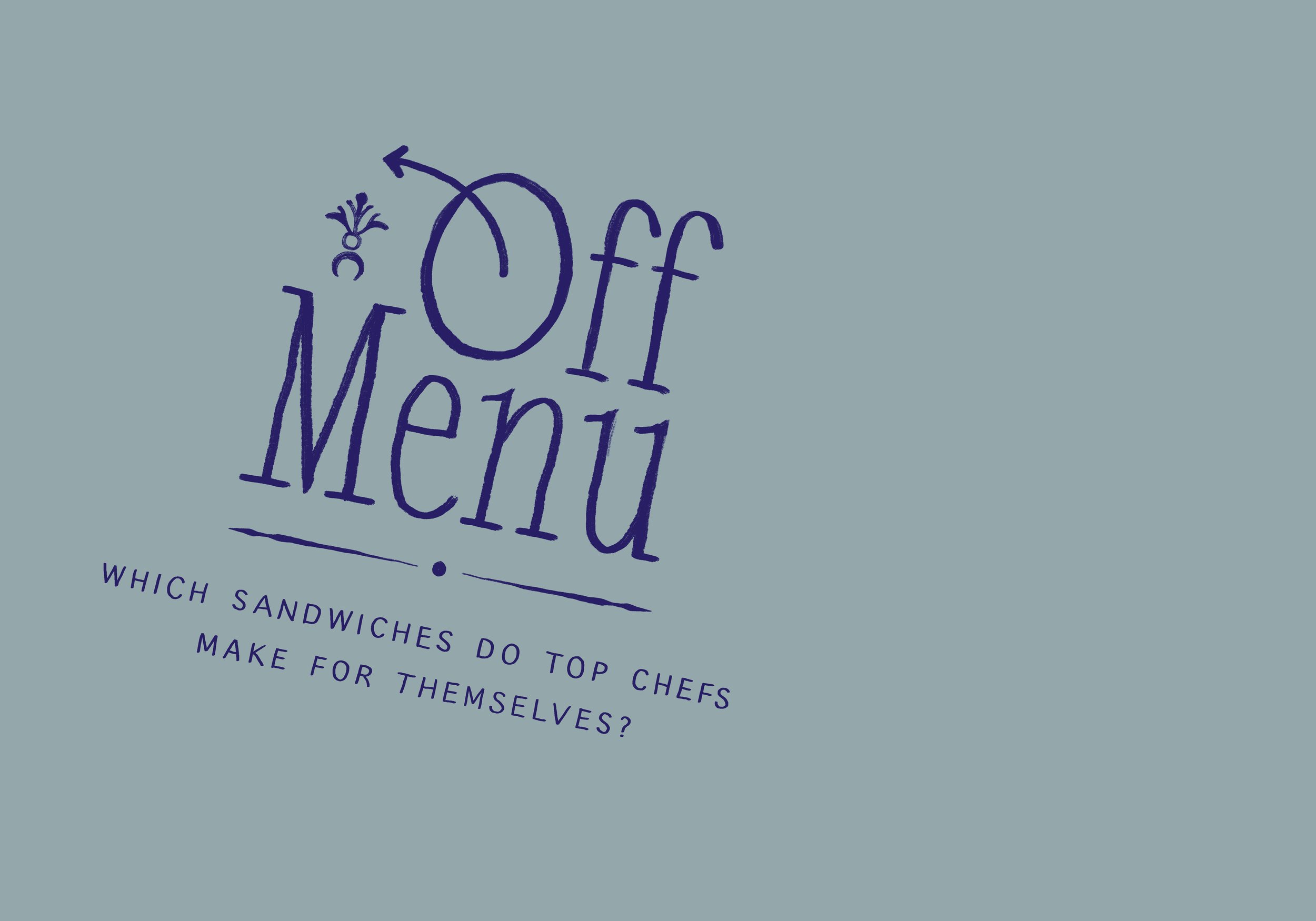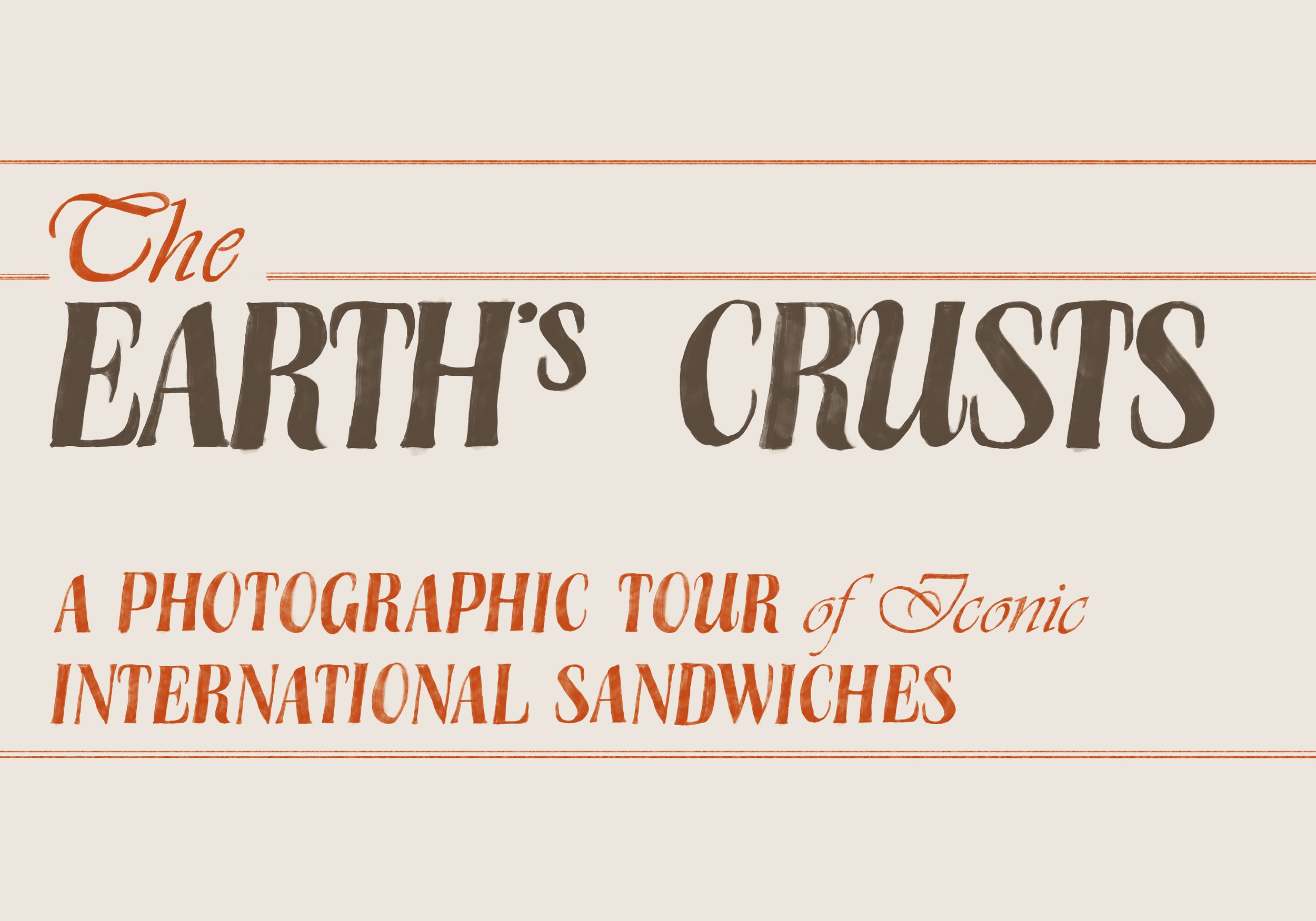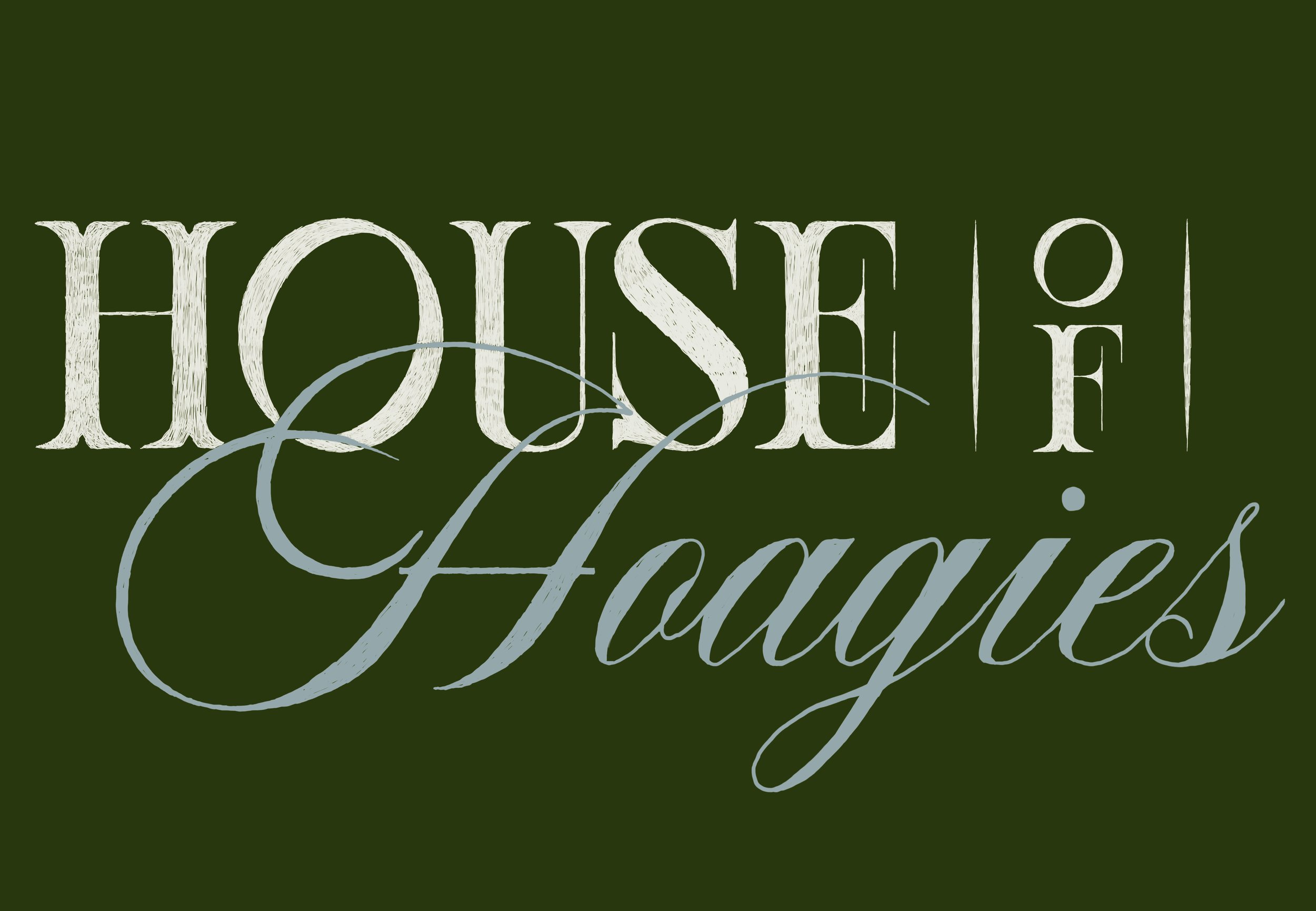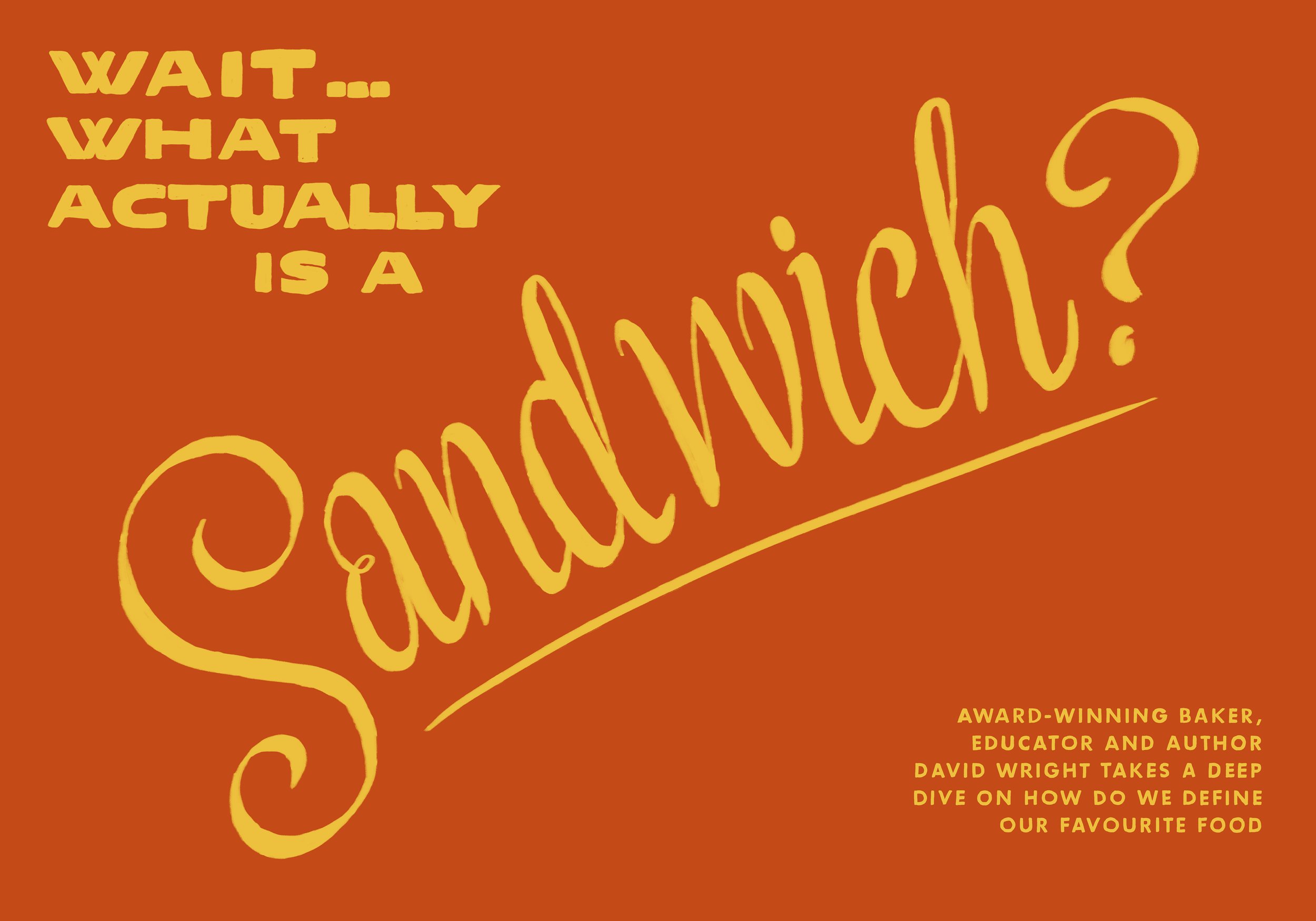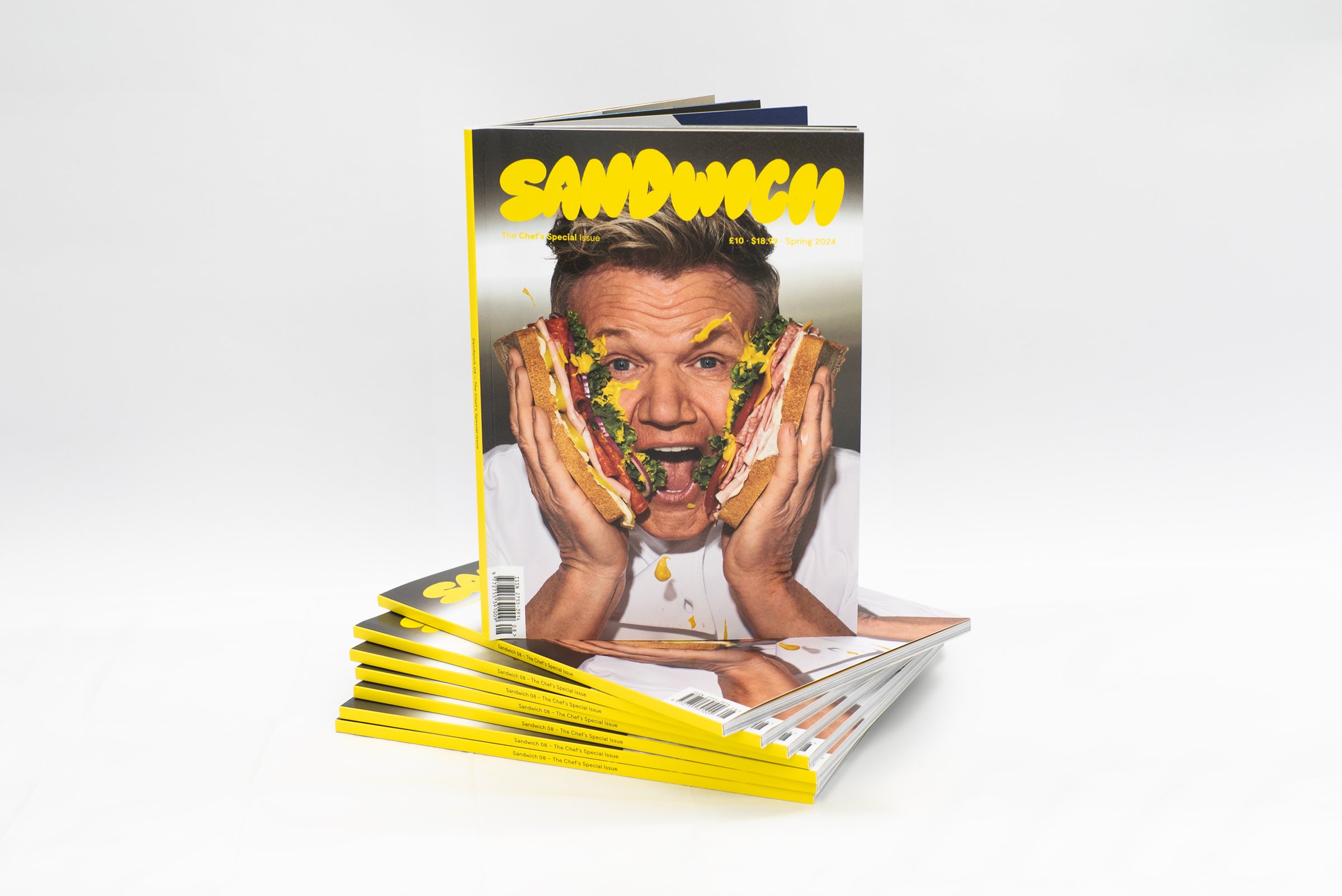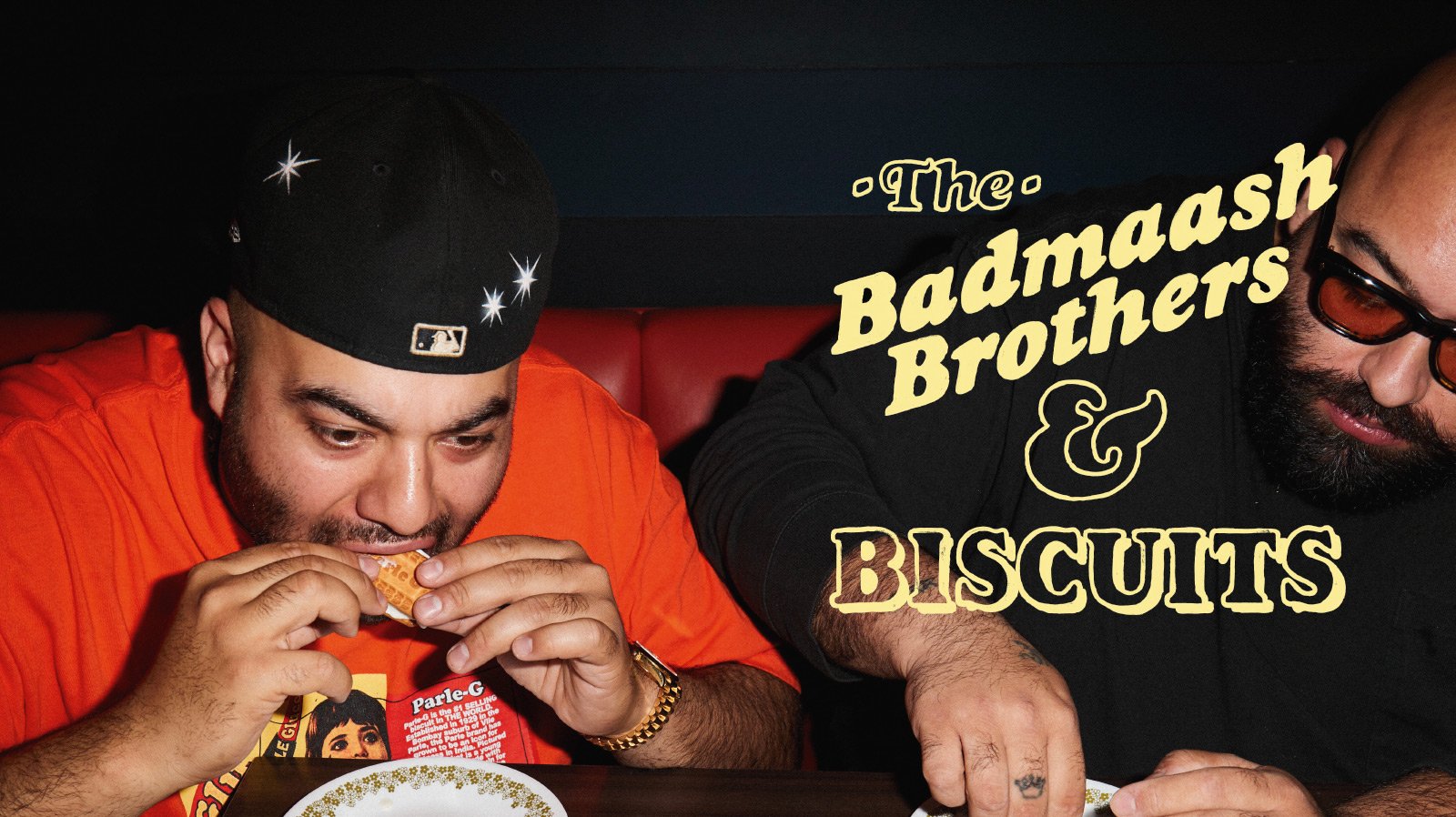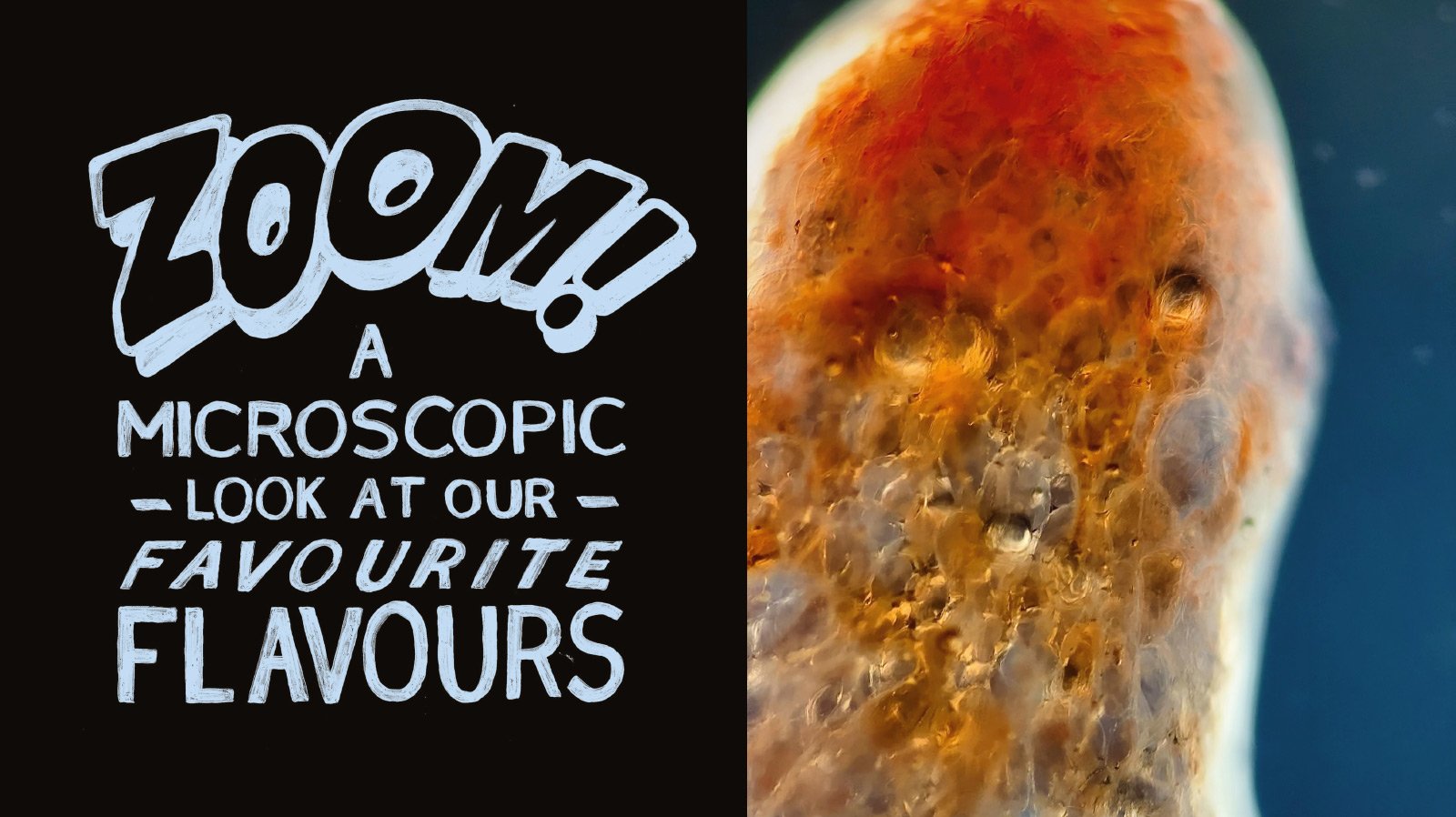The Badmaash Brothers & Biscuits
Words Gemma Lacey
Photography Mansoor
If you’ve heard of LA’s cult restaurant Badmaash, founded by brothers Arjun and Nakul Mahendro and their father Pawan, you’ll know they’re noted for their punchy flavours, spice and banging soundtracks. They’re also known for their signature ice cream sandwich, a delicate dessert made with the ‘world’s most popular biscuit’ – the Parle-G. Using one of the most recognisable biscuits in South Asia, the Mahendros first launched it at their original premises in Downtown LA. Sandwich sat down with the ebullient brothers as they prepare to celebrate 10 years of Badmaash DTLA to discuss their delicious ice cream sandwich and their unique way of smashing together Indian, Canadian and American food and nostalgia.
Why did you decide to have an ice cream sandwich on the menu?
Arjun: We needed to have Parle-G biscuits on the menu. It’s just such an iconic cookie. It’s not even a cookie, it’s just an iconic brown thing. You know what I mean? Any kid who grew up, wherever you grew up in India, Pakistan, Canada, they just know Parle-G.
Parle-G is one of the world’s best-selling biscuits, what do you think makes it so special?
Nakul: Everyone knows Parle-G. Adults have Parle-G, kids have Parle-G. There’s something so alluring about the package with this young girl holding up her fingers, she kind of looks like she’s throwing up gang signs. So it’s like Arjun and I, we grew up having this allure for Parle-G and then when we were older and getting into business for ourselves, having the allure of Parle-G, this icon of Indian excellence that’s available globally, we had to have it on the menu. Ice cream sandwiches are so easy to enjoy. We love vanilla ice cream with something crispy.
If you could describe the flavour of a Parle-G biscuit, to someone who’s never eaten one, what would you say?
Nakul: A grandmother’s hug?
Arjun: It’s a little less spicy, less sweet, and less dense than a Biscoff. It’s a little airy. You get this cloud of glucose and ethnicity when you bite, like a light and milky sweetness.
Okay, let’s talk about the ice cream you pair it with, what kind is it?
Nakul: It’s Blue Bunny vanilla ice cream – that’s the best, straight up.
Why that one in particular?
Nakul: It’s an everyman ice cream. For us, the simple things are often the best. We were the first ones to do the Parle-G sandwich and since we did it, we’ve seen other Indian restaurants here in this part of the world, as well as over in Asia, in India, doing it. You get it with chai ice cream, or you get it with gelato, dipped in rose water or sprinkled with dark chocolate and pistachios, › and it’s cool. But the simple things, the uncomplicated foods are always the ones that hit the hardest on the palate, as well as on the soul. So it’s like KISS: keep it simple, stupid.
You’re famous for big, bold flavours at Badmaash. Do you think having simpler things like an ice cream sandwich on the menu makes it more relatable to people new to this type of cuisine?
Nakul: Oh yeah. I mean, that was how Badmaash was born. We opened this restaurant with two burgers on the menu. Now we only have one. We had a beef burger as well as the spiced lamb burger. The spiced lamb burger has stayed on the menu. We have fries, we have poutine, our entire menu since day one has been written in a language that locals can understand whether you’re Indian or not, if you’re from this part of the world. If you’re just someone who goes out to restaurants in any part of the world, you want to know what you’re eating. And so we don’t have these ’80s and ’90s fantastical ethnic restaurant descriptions like “cooked in the tribal way”. What does that mean? That doesn’t tell me about ingredients, flavour, or method of prep.
How did you develop that style?
Arjun: We started by asking ourselves what are the things that create a great restaurant? All great restaurants, even if they have $500 tasting menus or the $5 grub you get in a box, they’re relatable in some way. They have to be, they’re easy to understand and they’re just really fucking good in terms of food and service and so we started with that. Then we started to add Indian. We love fried chicken, so what can we do with fried chicken? Well, one of the things we tried was with butter chicken sauce. The Parle-G ice cream sandwich in particular, you get both. I don’t think there’s anyone on the planet who doesn’t enjoy an ice cream sandwich. And so there’s that for the Americans or people who don’t know what Parle-G is, but then when Indian or South Asian people see Parle-G ice cream sandwiches, they go bonkers.
So nostalgia is a big draw?
Arjun: For certain people, you’re getting that big nostalgic kick, and for other people who are just like, oh, damn, there’s an ice cream sandwich. I love ice cream sandwiches so it’s like the everyman kind of dish.
What else would you say on the menu is an everyman item that most people get excited about?
Arjun: Good question. Definitely the fried butter chicken sandwich and the lamb burger, and poutine – a lot of people love that. Also, poutine is a Canadian dish that we grew up eating.
Do you make that with traditional cheese curds or are you using paneer for that?
Nakul: Traditional cheese curds. It’s very pretty close to a traditional poutine. We just kind of put a little bit of our Indian spice on it, just like chicken tikka on top and some cilantro. We spice the fries a little bit with our paprika. A lot of our dishes are like 50-50 in terms of Indian or American, or Indian or French, or they’re more heavily weighted towards the Indian side. Our slow-cooked short rib, we cook in a very traditional French method but we cook it with Indian flavours. So I would say that’s like 70% continental and 30% Indian. But then you have dishes, the poutine, which I would say are the flip of that. They’re like 70, maybe 80% tradit-ional Canadian poutine, and then 20/30% Indian flavour.
Arjun: Those are just the dishes that we have fun with. I mean, most of the menu, more than 50% of the menu is super traditional. And my favourite thing is when you get an Indian auntie who comes in and she’s not happy with the music, with the noise level, wearing her traditional Indian clothes, and by the time she’s done her meal, she has the biggest smile on her face. And her child-ren or whoever brought her are like, “yo, my mom loves this restaurant”. So you definitely don’t play around with the traditional items either.
Food seems to be the thing people miss most when they move abroad. What food did you crave when you moved to LA from Canada?
Arjun: When Nakul and I moved here, we would go out drinking downtown and the only thing they were serving was tacos. Crazy tacos or hot dogs with bacon on it and we’re just like, these are cool. I like ‘em, but I need a poutine. We needed that hit. So when we opened up our restaurant, › we’re like, okay, we’re putting a poutine on the menu. It’s become a staple dish, and people just lose their mind over it.
“When we do stuff, we take everything into consideration, like feel to bite ratio.”
What’s been the most controversial dish you’ve ever had on the menu?
Nakul: We had a fun dish when we first opened, and we sometimes bring it back as a special, it’s called ‘Holy Cow! Keema Pow!’ Just having beef short ribs on the menu is a big thing. People eating beef at an Indian restaurant?! But beef is amazing and Indian people love beef. People get a little shocked when we have pork on the menu too.
Is that because the cow is considered sacred?
Nakul: Yeah, the cow is a sacred animal. The cow is a pet of the gods, Shiva has a cow, Krishna has a cow. Cows help you farm, they provide milk and cheese and all these essential things. But as a Hindu, we shouldn’t be eating any animals. We’ve just always thought it was funny being brought up in this part of the world as Indians. There are a lot of things that we see that have kind of made us go like, “ah, that’s interesting”. Or, “oh, that’s funny”. You see the uncle who’s preaching you shouldn’t eat beef, it’s really bad. And then he throws a cow hide leather jacket on.
Do you think Asian food has a more spiritual element to it? For example the way they wash rice?
Arjun: Yeah, I mean, we wash the hell out of our rice. There’s a minimum of five washes until the water's completely clear. All of our food, all the traditional food we do is very traditional… tedious. We get all of our spices from India, roast them individually, then grind them, and put them together. So there’s really no shortcuts. We don’t use box spices or anything like that. Same with our staff, we’ve had people who’ve been with us for 10 years.
Speaking of that, restaurants are notoriously difficult businesses. What do you think are the reasons that you have been able to run yours so successfully? Is it from that foundation of love for what you do? Or are there other factors at play?
Arjun: Definitely a foundation of love. When we first opened our father was here 800 days in a row, I remember even on some of the biggest holidays, we’d be sitting right here, and we’d be talking about how we can make this restaurant better. We’ve slept in here before. So the foundation is definitely there. We love what we do. We’ve been doing this our whole life, I’ve been a busboy since I was 14 years old. We instil love too, even the people we hire over here, it’s not resumé based. It’s human-being based, personality based.
Nakul: We have very high regard and very high value for our guests. It’s very common in this business to, after some sort of success, take certain shortcuts in food service, or a relaxed approach to certain elements in this business. There are so many things that happen here, from the playlist to the writing of the menus, to the colours of the font of specials that we’re going to only use for a few days. We obsess over all those little things because we know that they ultimately will either help or detract from the happiness created within our guests. So we’re obsessed with guests, we’re obsessed with making them happy and that feeds into everything. That’s the foundation of everything.
What’s the biggest compliment you’ve had from a guest that you can remember?
Arjun: An Indian guy told me he was born and raised in America, in New York, and he said to me, “you made me feel comfortable and cool about being brown”. I thought that was pretty heavy. The Indian community will often hit us up on DM or in person just saying, “yo, you inspired me to do this, or because of you guys. I created this”.
Speaking of your creations, and back to the ice cream sandwich, yours is pretty delicate by US dessert standards. Was it governed by the size of the Parle-G’s?
Arjun: It’s more than that, It’s a good balance. It’s a good bite. It holds well in your hand. I mean, when we do stuff, we take everything into consideration, like feel to bite ratio. I mean, we built a burger restaurant and the entire time we were building burgers, we were eating burgers for nine months to a year, and the size of the product in your hand and everything like that matters.
What’s your earliest example of eating Parle-G’s?
Arjun: We just ate them out of the packet, and they usually come out broken, and when we started doing this ice cream sandwich we always had these broken cookies, and I just see people eat them, or we would toss them, and I said, no, man, we’ve got to do something with them. So we did this special for a month, which I am bringing back, no question. It’s Parle-G fried chicken. We took all the crumbs, we blasted it, we patted it on our badass chicken tikka that we do, deep fried it. So it was that but with a sweet cookie on it, that sounds insane. It was so good. SO good.






